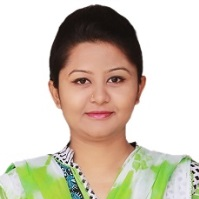
Taslima Ferdaus Shuva
Work place: Department of Computer Science and Engineering, Daffodil International University, Dhaka, 1207, Bangladesh
E-mail: shuva.it.ju@gmail.com
Website:
Research Interests: Autonomic Computing, Network Architecture, Network Security, Data Structures and Algorithms
Biography
Taslima F. Shuva has completed her B.Sc. (Hons.) in Information Technology from Institute of Information Technology, Jahangirnagar University, Savar, Dhaka, Bangladesh in 2014. She is currently working as a Lecturer in the Department of Computer Science and Engineering, Daffodil International University from 2016. Her research interest is in Wireless Communication, Cloud Computing, and Network Security.
Author Articles
Efficient Sensor-Cloud Communication using Data Classification and Compression
By Md. Tanvir Rahman Md. Sifat Ar Salan Taslima Ferdaus Shuva Risala Tasin Khan
DOI: https://doi.org/10.5815/ijitcs.2017.06.02, Pub. Date: 8 Jun. 2017
Wireless Sensor Network, a group of specialized sensors with a communication infrastructure for monitoring and controlling conditions at diverse locations, is a recent technology which is getting popularity day by day. Besides, cloud computing is a type of high-performance computing that uses a network of remote servers which simultaneously provides the service to store, manage and process data rather than a local server or personal computer. An architecture called sensor-cloud is also providing good services by combining the capabilities from both ends. In order to provide such services, a large volume of sensor network data needs to be transported to cloud gateway with a high amount of bandwidth and time requirement. In this paper, we have proposed an efficient sensor-cloud communication approach that minimizes the enormous bandwidth and time requirement by using statistical classification based on machine learning as well as compression using deflate algorithm with a minimal loss of information. Experimental results describe the overall efficiency of the proposed method over the traditional and related research.
[...] Read more.Other Articles
Subscribe to receive issue release notifications and newsletters from MECS Press journals